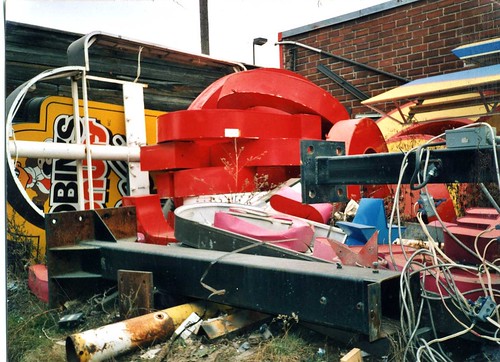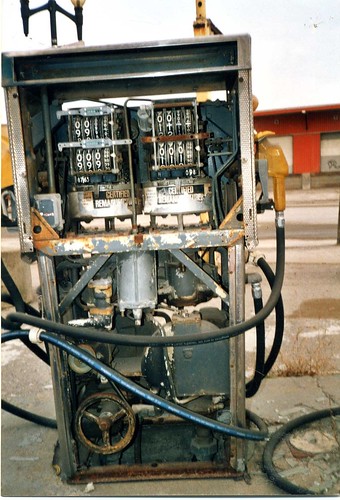Got my hands on a scanner recently and thought I’d post some pics snapped around 2001, during my first excursions through Pointe St-Charles and Griffintown (I didn’t learn the names for these neighbourhoods until years later). These photos are from the period in my life when the city was transformed from an unremarkable backdrop into a personal Muse.
There was something so inspiring about discovering parts of the city that were messy and unstructured. I don’t know which was more shocking: encountering horses in an urban stable, or stumbling upon a parking lot of blown-up STM buses by the Lachine canal. One of my favourite finds was the grocery store sign graveyard pictured above. The stack of big red letters spell out “Super C”, but there were also retired signs for every other grocer from IGA to Esposito.
The Sud-Ouest was – and remains – full of “Grey Spaces,” pockets urban land that are neither privately secured, nor programmed for public use. Often these places hold tangible relics of their past, like the gas pump below, but retain a sense of possibility; their history has neither been glossed over, nor set in stone.
I believe that these Grey Spaces are what many people fear losing altogether in mega-developments like the Griffintown Project. But, in a system where developers are regulated by urban planners (if they are regulated at all), is it possible to ask for some places to remain, simply, unplanned? Instead, we demand more public space in the hopes that this will preserve a certain sense of anything’s possible in the urban landscape. Instead, we are offered sleek public squares, stylized benches, and playgrounds that close early.
This post represents the opinion of it’s author and is, as always, up for debate in the comments…



5 comments
In conversations with friends about architecture and public spaces, one subject that keeps returning to the table is that of usage.
No one wants to live in apartment-only “communities” – bedrooms stacked one on top of the other – with no one from the community offering “normal” services around such areas.
Neighbourhoods suffer and become ghettos when there is not enough life – no reason to walk on the street in the evening, nowhere to buy a loaf of bread, nowhere to sit and have a non-corporate coffee. Case in point would be the area near Maquire and Henri-Julien — for but one example of fairly recent development and ongoing development of a neighbourhood. Look also to the other side of St-Denis to see row after row of 4 and 5 and 6 story condos and not a café or depanneur or a public green space in sight.
What is still needed in this city are more streets in new developments that contain mixed commercial and residential use. I, for one, being a craft/trade person, would love to have the use of (most likely to rent, but possibly to purchase) a smallish two-story place that contains both my workspace with my living space upstairs. And I would like it to be near other structures with the same kind of mixed-use.
Of course thinking about such things makes me dream of vibrant evening streetscapes and a lively neighbourhood where you really know your neighbours. I’d think this is something we’d want… right?
It seems to me that this feature of Montreal architecture is being eliminated – or not considered at all – in new development areas, and this is a serious shame and a great omission, to my mind.
(ok, “no one” IS a bit of an exaggeration. But I bet if you asked these people who bought stacked bedrooms if they’d like to have services close by that aren’t big box things, the answer would be a resounding “yes!”).
Are you going to post more of this series of photos? They are amazing and I’d like to see more of those weird city relics.
I agree with the “unplanned” concept. A vacant lot can sometimes become an almost culturally vibrant place in it s own curious local way. The biggest problem with new developments, such as the proposed one for Griffintown, is that they are mercilessly uniform no matter how multi purpose they claim to be.Take a good look at Montreal and you will see it is the triplexes that have aged gracefully and it is because of their low height, materials, workmanship and astonishing ability to adapt visually and physically.
A lot of the development is really cro-magnon. The autoroute notre-dame project looks like one example.
Going up Côte-des-Neiges from rue Sherbrooke is another magical mystery tour of bad urbanism — lots of huge apartment towers with no stores, all set back from the street to allow space for cars.
I was wondering if you’d sent in a memoire about the griffintown project. I went to one of the consultations and there was one woman who talked about these sort of Jacobs-ian concernts, but most of the speakers were focused on socio-economic effects and the obligatory “espaces verts”.